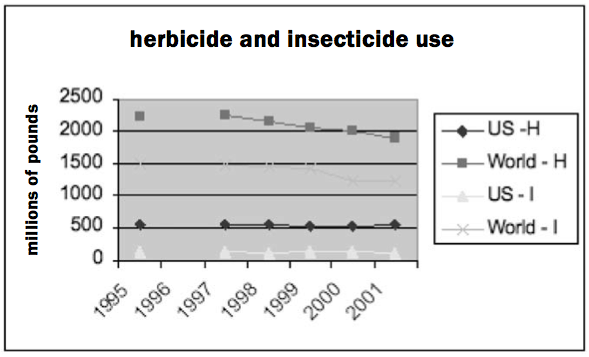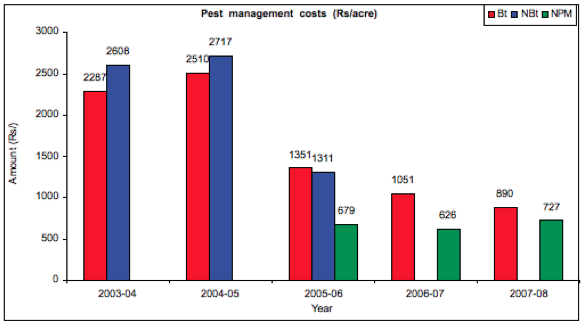The biggest problem with genetic engineering in agriculture is that it runs completely against the grain of sustainable agriculture. It separates the domain of science from the domain of farming community. It externalizes everything that was internal to the communities and formed the basis of sustainability: seeds, manure, pest control and more than anything, community knowledge of agriculture. Biotechnology in agriculture today stands as the manifestation of corporate power that is shaping the food and farming policies in India. That is the reason why we must see biotechnology less as science and more as politics.
Genetic engineering (GE), strangely, rides on the slogans of feeding the world and sustainability. It also claims that transgenics, a major product of biotechnology, can increase yields and reduce pesticide use, two traits that have produced more controversy than success. In order to examine the veracity of these two claims let us look at the home of transgenic crops, the United States, which was the first country to grow GE crops and is still the largest planter of GE crops today. Nearly 55 percent of all genetically engineered crops in the world is cultivated in the US More than 90 percent of all soy planted in US and 85 percent of all corn planted in the US are genetically engineered. In spite of this carpeting of the country by GE crops, has the yield dream been realized?
According to the US Department of Agriculture (USDA), the soy yield in the US did not increase by even 1 percent between 1995 and 2005. These years correspond to the prime GE period in US soy production. Instead of increase, soy yields fell from a peak of 42 bushels/acre in 1994 to 39.5 in 2009. In the interim years, it never touched the peak of 40 bushels/acre. This performance does not look any better when we compare the yields of Round Up Ready Soy, an herbicide-tolerant GE soy, with conventional soy yields. In eight US states where this yield comparison was studied, it was the conventional soy that out-yielded the Round Up Ready Soy in all but one state, according to the USDA. Biotechnologists themselves describe this as “Yield Drag.”
Let us look at corn production, another favored GE crop. Corn production in the US, which stood at 140 bushels/acre in 1995, nearly reached 150 bushels in 2008, a mere 7 percent increase in 13 years! So where is the promised yield? A KansasUniversity study in April 2008 showed that the productivity of GM crops (soya, maize, cotton and canola) was actually greater in the era prior to the introduction of GM seeds. Soy showed a drop in yield of up to 10 percent.
In 2007, NebraskaUniversity found that Monsanto’s GM soy produced 6% less than the same variety of the company’s non-GM version, and up to 11% less than the best available variety of non-GM soy. Other studies, including a USDA study in April 2006, show similar results. Categorically, GM seeds are not the most high-yielding.
The main reason for the lower productivity of GM crops, the studies explain, is that genetic modification changes the metabolism of the plants, which in some cases inhibits the absorption of nutrients and, in general, demands more energy to express characteristics that are not natural to the plant, denying it the ability to develop fully.
When confronted with these facts, Monsanto’s explanation was that “genetically modified seeds are not designed to increase yields” (Lean 2008). While Monsanto has tried to explain itself out of this corner, its claim that its GE crops reduce pesticide use has not been muted. If at all, this is the resounding noise that the company makes.
Let us examine this claim from the US experience. The graph below issued by the US Environmental Protection Agency explains the total pesticide use in the US compared to the rest of the world. Obviously, with more than 55 percent of all GE crops being grown in that country, US pesticide use must be significantly less than the rest of the world. It is not so.

Between 1998 and 2002, world consumption of herbicides and insecticides indicate a clear downturn. But in the US they are as flat as an airstrip, another loud testimony to the fact that GE crops have not been able to decrease pesticide use.
In India it is the same story with Bt cotton, the first and the GE crop grown in the country. The Deccan Development Society, of which I am the Director, and the Andhra Pradesh Coalition in Defence of Diversity, have been studying the impact of Bt cotton, particularly on the small and marginal farmers’ fields in the South Indian state of Andhra Pradesh between 2002 – the year when Bt cotton was introduced – and 2009. What are our findings today?
The industry introduced Bt cotton with a bouquet of promises, that:- Bt cotton is a cutting-edge technology.
- It is the answer to all cotton problems.
- Use Bt cotton, it will lower the cultivation costs.
- It will bring down the pesticide use significantly.
- It will give farmers higher yields.
- It will earn them higher profits.
What was the outcome after five years, in 2007?- Cultivation costs for Bt Cotton went up significantly.
- Bt yields did not increase more than 5 percent.
- Pesticide use has failed to come down.
Small farmer earnings by cultivating Bt cotton are on the negative. They have lost more than what they have gained.

The graph above on pest management costs incurred by Bt and non–Bt cotton farmers between 2002-3 and 2006-7 tells the complete story (Qayum and Sakkhari 2008).While the first year of Bt cotton gave a marginal pest management edge to Bt growers, the very next year, Bt farmers spent almost the same amount of money as the non-Bt farmers. Bt gave them no special advantage. Between 2005 and 2007 the study concentrated on the comparison between Bt growers and those farmers who had managed their pests under non-pesticidal management (NPM) methods. The NPM farmers scored a clear advantage. Their pest management costs, depending on rain and pest incidence regimes were far lower than the Bt farmers, sometimes just about 50 percent of the Bt farmers.
Over these five years, non-Bt farmers invariably recorded higher net returns than the Bt farmers. In 2004, Bt farmers actually had a negative return while the non-Bt farmers always had a positive return. Another study on Bt cotton in the south Indian state of Karnataka, by three researchers from the University of Hannover in Germany, tells a similar story (Malkarnekar et al. 2006). They found that Bt farmers suffered miserably in the first year and recovered marginally in the second. But even then they had lost nearly 20 percent more money than the non–Bt farmers. Beyond monetary gains and losses, Bt cotton has caused long-term ecological devastation, in the form of serious damage to soil health, the return of forgotten insects, a severe incidence of non-target pests, harm to animal and human health, and death to humans and animals.
Rhizectonia, the root rot disease which was rarely seen in the cotton belts of Andhra Pradesh, increased from zero in 2002 to 40 percent of the soils growing Bt cotton in 2007. The consequent wilt disease spread like wildfire in many fields, particularly of the small farmers. In despair farmers had to pull out the crops planted by their own hands and burn them. For an Indian farmer, this is akin to killing his own child. Nothing can make them feel more devastated.
One clue to this phenomenon was suggested by a study at the Indian Agricultural Research Institute (IARI), New Delhi, which argued that transgenic Bt cotton may constrain the availability of nitrogen, but enhance phosphorus availability in some soil types in India (Kirtiman 2008). Another IARI scientist, Dr. K.R. Kranthi of the Central Institute for Cotton Research, Nagpur, said in one of his studies that Bt cotton may affect soil microbes and nutrients available to the plants. While conclusive reasons for soil degradation have not been found, it is clear that the soils growing Bt cotton were turning toxic in various parts of India.
On the pest front, the sucking pests had a heyday occupying the space left by the helicoverpa while the long forgotten mealy bug, a pest that once flourished in the ’60s, came back menacingly to occupy the cotton crop in Andhra Pradesh and Punjab. As a report in the Business Standard (India) explained: “2005, the mealy bugs had destroyed almost the entire cotton crop in several parts of Pakistan, notably in Multan, Sanghar, Mirpurkhas and Tandu Allahyar areas” (Sud 2008). Punjab farmers also paid a very heavy price for this pest, in the 2007 season. Such incidents are warnings that targeting a single pest in a non-holistic fashion, and not the complex causes, is dangerous.
Human and animal diseases
In Andhra Pradesh, Bt cotton weeders and pickers suffered skin allergies that they had never experienced before. The same allergy afflicted animals like goat and sheep. In the year 2005, over 2,500 sheep died grazing the leftover Bt cotton stalks (traditionally cotton fields are opened for grazing after the harvest is over). In the beginning the industry papered over this saying that they were, after all, small ruminants. But when buffaloes also started dying (we have counted nearly 12 of them), the answer by the industry was a deafening silence.
This prompted the researchers from Deccan Development Society and Anthra, an organization devoted to animal health, to start an experiment of feeding the sheep under controlled conditions. Three groups of sheep were separated and each group was fed with stalks from Bollgard I, Bollgard II and Non Bt cotton. While two sheep fed with Bollgard I died within 3.5 weeks of the start of the experiment, one sheep fed on Bollgard II died with them. By the end of the fourth week, all the sheep fed with Bollgard had died, while the sheep that did not feed on them stayed alive.
While all this was happening around them, and the farmers started losing their crops, money and hope, a sense of despair enveloped them in the cotton belts of Andhra Pradesh. As a result, several farmers committed suicide. Thus it was ironic that Bt cotton, which was purveyed as a panacea against the farmer suicides, became its cause.
These tragic series of events led to huge protests by Bt cotton farmers. They blocked the main roads through sit-ins, attacked the seed depots, burnt hoardings of Bt seeds and expressed their anger in so many ways. It was quite a dramatic sight to see policemen guarding seed and fertilizer shops from farmers, the very people needed to sustain them.
The Government of Andhra Pradesh instituted its own inquiry into the failure of Bt cotton in 2005 and banned Monsanto seeds. It is another story, but huge pressures from trade and industry as well as the US Government were brought to bear on the Government of Andhra Pradesh, which caved in under such pressures and revoked its ban order.
While all this was happening, the industry continued to paint a rosy picture of Bt cotton. A number of industry-commissioned studies by commercial opinion pollsters claimed that Bt cotton had increased yields, reduced pesticide use, enhanced profits and changed the destiny of cotton farmers. And there were many scientists, prominent among them Dr. Qaim of the University of Bonn, who tried to explain away these problems as arising from “susceptible germplasm.” The same set of arguments came from a stable of scientists who are committed advocates of biotechnology. All of them continued to claim that Bt cotton was succeeding in helping the poor. How does one explain this obvious contradiction between the ground reality and scholarly assertions?
Dominic Glover (2009) from the prestigious STEPS Centre of the Institute of Development Studies, University of Sussex, offers some explanation for this contradiction:
This review of studies on the impacts of Bt cotton in China, India and South Africa shows that there is clear evidence of selectivity in the way that partial, ambiguous and equivocal data has been interpreted and represented. In all three cases, the story of success that has been highlighted on the surface has been shown to be, if not untrue, certainly only part of the story…. in a number of different, subtle but identifiable ways, encouraging results have been emphasized, while negative ones have been downplayed.
So the controversy rages on. There is no concerted effort by the scientists outside of the corporate control and the government bodies to come together to make a dispassionate analysis of agrobiotechnology, particularly transgenic crops, especially when it is about to make incursions into our food crops. Starting with Bt eggplant, a host of food crops such as rice, mustard and soy are on the verge of getting approval for commercial cultivation by India’s weak regulatory body. While on the threshold of this catastrophe, it will be worth our while to look at some of the warnings issued by Professor Jeffrey Smith (2007) of the Institute for Responsible Science in the US:
The prevailing worldview behind the development of GM foods was that genes were like Lego blocks, independent pieces that snap into place. This is false. The process of creating a GM crop can produce massive changes in the natural functioning of the plant’s DNA. Native genes can be mutated, deleted, permanently turned off or on, and hundreds may change their levels of expression. The inserted gene can become truncated, fragmented, mixed with other genes, inverted or multiplied, and the GM protein it produces may have unintended characteristics with harmful side effects.
Thus the promise of biotechnology in agriculture sounds very hollow. As people who have worked at the grassroots with farmers who have planted Bt cotton and have suffered heavily as a consequence, we feel the thick blanket of half-truths that wrap the dark secrets of the “success stories” of genetic engineering.
References
- Glover, Dominc. 2009. “Undying Promise: Agricultural Biotechnology’s Pro-Poor Narrative, Ten Years On.” STEPS Working Paper 15. Brighton: STEPS Centre.
- Kirtiman, Awasthi. 2008. “Bt’s Soil Chemistry.” Down to Earth. (October 31, 2008).
- Lean, Geoffrey. 2008. “Exposed: The Great GM Crops Myth,” The Independent (U.K.). (April 20, 2008), at http://www.independent.co.uk/environment/green-living/exposed-the-great-....
- Malkarnekar, Ashok, Diemuth Pemsl and Hermann Waibel. 2006. “Technology Adoption Under Heterogeneity and Uncertainty: The Case of Bt-Cotton Production in Karnataka.” Hannover, Germany.
- Qayum, Abdul, and Kiran Sakkhari. 2008. “Another Year of Doom: Bt Cotton in AP.” Andhra Pradesh, India. Deccan Development Society.
- Smith, Jeffrey M. 2007. Genetic Roulette: The Documented Health Risks of Genetically Engineered Food. Deccan Development Society and Other India Press.
- Sud, Surinder. 2008. “From Bollworms to Mealy Bugs.” Business Standard. (March 11, 2008), at http://www.business-standard.com/india/news/surinder-sudbollworms-to-mea....
This essay is adapted from a presentation made by P.V. Satheesh for the National Seminar on Genetic Engineering, Food and Farming, Institute of Engineers, Mysore, India, on November 7, 2009.
 Buy at Levellers Press
Buy at Levellers Press 
